Nina Munteanu's Blog, page 13
October 14, 2012
Writing About Truth…and Other Lies

So,
what is it to write about truth?
Many
of you are familiar with the term “write what you know”. I wrote an article on
Scribophile about this topic. In it I shared
some excellent advice from Literary Agent Rachelle Gardner: “Write what you know means write with authenticity
about thoughts, feelings, experiences of life. Be honest. Write from a deep
place. Don't write from the surface. Whether you're writing about parenthood or
cancer or anything else... be real. Don't reflect what you know from other people or
the media... write what you know
from your own inner life.” The advice write what you
know isn’t about literal truths; it’s about what you know inside. And as SF
author Marg Gilks says, “You know more than you think.”
So,
what is it to write about the truth?
Here’s
a bit of truth from New York Times reporter Stephanie Strom in an article on
September 19th, 2012, entitled Uneasy
Allies in the Grocery Aisle: “Giant bioengineering companies like Monsanto
and DuPont are spending millions of dollars to fight a California ballot
initiative aimed at requiring the labeling of genetically modified foods. That
surprises no one, least of all the proponents of the law, which if approved by
voters would become the first of its kind in the nation.”
Let’s
dig a bit deeper into this truth: “companies behind some of the biggest organic
brands in the country—Kashi, Cascadian Farm, Horizon Organic—also have joined
the anti-labeling effort, adding millions of dollars to defeat the initiative,
known as Proposition 37.”
Strom
reveals even deeper truths when she discloses that these well-known “organic”
companies are owned by larger conglomerates like Kellogg, General Mills, Dean
Foods, Smucker’s and Coca-Cola. Other food companies who have thrown in funds
to help defeat the bill for transparency include PepsiCo., Neslé, and ConAgra Foods.
Strom
reports that those who support the bill to label GMO products include Whole
Foods, Nature’s Path (a Canadian company) Organic Valley, Cliff Bar and Amy’s
Kitchen.
Whenever
an issue of importance arises, the truth reveals itself. And sometimes in the
oddest way. It often slides in through a back door in nuance, motion, color. I’m
not just talking about factual truth; I’m talking about resonating hair-standing gut-grabbing truth. The kind of truth that
resonates through you in a scintillating frisson that sparks of thrilling
unfamiliar yet calms you with the warmth of home. The kind of truth that stops
you mid-stride, like someone shouting your name. Subversive truth. The kind of
truth that vibrates deep inside and radiates out in a warm flood of epiphany. The kind of truth that stirs your heart in a
relentless wave of flaming light.
At
first glance it’s rather obvious why those fighting the bill are against it:
they have something to lose in transparency. The question is, why do they think
that way? These giant biotech food companies are feeding the entire world,
after all, with revolutionary strains of super-plants. They are doing a great
good, surely. Could it simply be a concern that they may lose some customers
who do not wish to consume GE products but who are unwittingly doing so now?
That is being dishonestly self-serving as well as short-sighted (the European
Union has required biotech labeling since 1997—it’s just a matter of time).
Could
it be the recent bad publicity from findings of the long-term effects of GMO
products and Roundup on test animals? (See the incendiary paper by French and
Italian scientists in Food Chem. Toxicol.,
referenced below). Despite the barrage
of bad press (wonder who’s behind most of that?), the paper’s results cannot be
refuted entirely or ignored (if only from the basis of scientific inquiry and
professional due diligence to do with Type II Error).
Or is
it more insidious?
There
is something far more insidious than a lie; that is to dissemble with a half-lie—or
half-truth—a truth that veils a festering lie beneath its candy-coated mantle
of equivocation. A “truth” so delicious that we want to believe it, even when
we see the lie lurking beneath. Little lies always hide bigger lies.
For
more than a decade, consumers in North America have purchased cereals, snack
foods, and salad dressings, among other products, blithely unaware that these
products contained ingredients from plants whose DNA was manipulated in a
laboratory.
Here’s
my witnessed truth: The aggressive multi-million dollar campaign waged by
multi-national corporations against transparency in food labeling in the USA is
the culmination of self-serving protectionism in a most heinous way. Their
decade-long silence and current reluctance to label their products (and all
this before the Seralini et al. study) points to a far greater lie.
Since
the long-term toxicity study by Seralini et
al. was released in Food &
Chemical Toxicology last week, a massive campaign to discredit the study
has been waged on the Internet. This despite the soundness of the 2-year study,
its glaringly obvious results (e.g. test animals died 2-3 times more quickly
than controls among many other findings) and the fact that it sets precedent by
being the longest and most detailed study ever conducted on a herbicide and a
GMO to date; all previous studies by Monsanto labs and others were only 90-day
trials.
So,
what is it to write about the truth?
I’ve
been a practicing scientist for over twenty years. I did research and wrote
papers that were published in scientific peer-reviewed journals. I diligently used
the scientific method, hypothesis-testing, objective observation and
appropriate statistics to my work. I also write articles for magazines, blogs and
places like this site. I write short stories and novels. I write how-to books
and guidebooks. And I write letters. Lots of letters. In all this, I have made
a point to do my research. I try always to go to the source and verify my
information through cross-checking, and various other quality assurance
procedures I learned over the years to best represent and communicate the
truth.
For
instance, in writing this article, I perused many articles that presented both
sides of the several issues I covered, including the source paper by Seralini
et al.
Science
is the rationale tool for the pursuit of the truth. This is why scientists are
burdened to proceed under an objective protocol in their premise presentation,
experimental design, methodology and interpretation and conclusions drawn.
Because the introduction of error and bias is possible in each of these steps,
researchers with integrity ensure through design and quality assurance protocol
that these errors and biases are minimized. This includes the use of contols,
sufficient sample size and statistical power, blind or even double-blind
experiments and more. Experiments are reported with sufficient transparency to
be replicated (an icon of good science). Once they are reported in a paper,
results transform from science into politics.
Science
and its close cousin “pseudo-science” are the weapons waged in this issue of
GMO food labeling. But science is just a soldier. Who are the politicians
behind the soldiers of science and what are their motives? That is where the
truth lies.
In the
end, I have found that listening to the conviction of my heart, to my inner
“soul wisdom”, best serves the truth. Then again I prefer the resonating hair-standing gut-grabbing truth.
You may be interested in a previous article I wrote here back in 2007 about the potential ecological dangers posed by GE practices, the wisdom of labelling GE products and Nature's alternatives to GE. Here is an excerpt:
While developers of genetically engineered foods (GEF) strive to produce hardier and higher-yielding plants, ecologists throughout the world eye transgenics skeptically. They fear that these genetically altered plants, may escape into the wild and displace native plants with unforeseen and potentially devastating results. Dr. Wes Jackson, director of the Land Institute in Kansas, a non-profit research facility devoted to alternative agricultural practices, warns that, if misused, biotechnology may lead to the human-induced degradation of the genomes of plant species. “What is being more or less ignored” in the rush to biotechnology, he said in an interview with the Chronicle of Higher Education, “is that some of the same principles and processes that govern an ecosystem, like a forest or a prairie, also operate with genomes. The genome is a miniature ecosystem.”1 Thinking along the same lines, Jane Rissler of the Union of Concerned Scientists of America suggested that transgenic science practices may release a seemingly harmless gene into our food supply with life-threatening consequences.
Growing knowledge of potential risks to ecosystem and human health is prompting many to insist that GEFs be identified and segregated so that consumers can make a choice for or against them. Which brings us to the obvious question: what alternative to the use of GEFs will we find to feed our ever-growing populations? Rissler advocates an alternative vision for agriculture, one based on nature’s own balance, which she calls “sustainable agriculture” or biomimicry.
Go here to read the entire article, "Biomimicy: Nature's Alternative to Genetically Engineered Foods".
If you live in California, or even if you don't, I exhort you to support Proposition 37 this November any way you can. Our freedom--and truth--is at stake.
Reference:
Seralini,
G.-E., et al. Long term toxicity of a Roundup herbicide and a Roundup-tolerant
genetically modified maize. Food Chem. Toxicol. (2012). http://dx.doi.org/10.1016/j.fct.201208.005
Published on October 14, 2012 13:15
September 28, 2012
Why I Miss Ray Bradbury
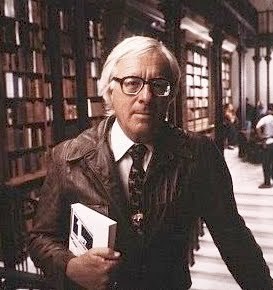
Ray Bradbury
In June of this year, Ray Bradbury—science
fiction & fantasy master and visionary and my hero—passed away at age 91.
Visionary premise and large ideas reign
in the genres of science fiction, fantasy and horror (whose borders Bradbury’s
writing seamlessly subverted: “What I have always been is a hybrid author”
Bradbury said in 2009). But Bradbury was far more than a brilliant visionary
like Clarke, Asimov and Heinlein. He was the undisputed King of Metaphor. His
subtle exploration and layered interpretations of the human psyche resonate
deeply. At the soul-level.
Ray Bradbury once told me that
everything I wrote was metaphor—every single word: from the verb I chose to
move a sentence to the name of a character. I remember coming close to tears
the last time I watched him speak at a conference several years ago in Palm
Springs; when he spoke so eloquently in that homespun sing-song voice about the
role of the writer as artist. It resonated so powerfully.
A while back, I wrote an article
on Bradbury’s writing as an example of the power of metaphor. The article was
entitled “The Martian Chronicles and Other Metaphors”:
They came because
they were afraid or unafraid, happy or unhappy. There was a reason for each
man. They were coming to find something or get something, or to dig up
something or bury something. They were coming with small dreams or big dreams
or none at all —Ray Bradbury, The Martian Chronicles
When I was but a sprite, and before I
became an avid reader of books (I preferred comic books), I read Ray Bradbury’s
The Martian Chronicles. It changed
me. It changed what I thought of books and what I felt about the power of
stories. It made me cry. And perhaps that was when I decided to become a
writer. I wanted to move people as Bradbury had moved me.
The Martian
Chronicles isn’t really about Mars. It’s about us. Who we are, what we are, and
what we may become. What we inadvertently do—to others, and finally to
ourselves—and how the irony of chance can change everything.
The 1970 Bantam book jacket so aptly
calls The Martian Chronicles, “a
story of familiar people and familiar passions set against incredible beauties
of a new world … A skillful blending of fancy and satire, terror and
tenderness, wonder and contempt.”
Written in the 1940s, the chronicles drip with a nostalgic
atmosphere — shady porches with tinkling pitchers of lemonade, grandfather
clocks, chintz-covered sofas. But longing for this comfortable past proves
dangerous in every way to Bradbury's characters — the golden-eyed Martians as
well as the humans. Starting in the far-flung future of 1999, expedition after
expedition leaves Earth to investigate Mars. The Martians guard their mysteries
well, but soon succumb to the diseases that arrive with the rockets —
recapitulating the tragedies that European colonization caused our indigenous
peoples. Colonists appear on Mars, most of them with ideas no more lofty than
starting a hot-dog stand, and with little respect for the culture they are
displacing.
Bradbury weaves metaphor into
everything he writes, from setting to a character’s name. I didn’t know this
when I was a young girl, enthralled by his stories, his characters, his scenes
and words. I just responded viscerally to what he’d created.
This is why Bradbury is one of my
favorite writers (possibly my very favorite; though he comes close to Thomas
Hardy). Bradbury, more than any other writer I know takes the strange—the
other—to show us who we are.
The
Martian Chronicles prophesized the banning of books, especially
works of fantasy, a theme Bradbury would take on fully in the 1953 release, Fahrenheit 451. Inspired by the Cold
War, the rise of television and the author's passion for libraries, it was an
apocalyptic narrative of nuclear war abroad and empty pleasure at home, with
firefighters assigned to burn books instead of putting blazes out.
In the
1967 introduction of his novel, Fahrenheit 451 (based on his novella, The
Fireman), Ray Bradbury implied that the Nazi book burnings helped compel
him to write his story: "It follows then that when Hitler burned a book
I felt it as keenly, please forgive me, as his killing a human, for in the long
sum of history they are one in the same flesh." For those of you who
haven't yet read his novel (one of my favourite books, ever), this cautionary
tale explores a fictional future society that has institutionalized book
burning in an effort by authorities to maintain order and 'happiness'. In this
world, firemen don't put out fires; they start them. By the way, 451 degrees F
is the temperature that paper catches fire and burns. The story begins with
Montag, an ordinary fireman:
"It
was a pleasure to burn. It was a special pleasure to see things eaten, to see
things blackened and changed. With the brass nozzle in his fists, with this
great python spitting its venomous kerosene upon the world, the blood pounded
in his head, and his hands were the hands of some amazing conductor playing all
the symphonies of blazing and burning to bring down the tatters and charcoal
ruins of history...Montag grinned the fierce grin of all men singed and
driven back by the flame. He knew that when he returned to the firehouse, he
might wink at himself, a minstrel man, burnt-corked, in the mirror."
Bradbury’s cautionary metaphoric tale
reminds us that it isn’t just them;
it’s us:
In his 1821 play, Almansor, the German writer Heinrich Heine (referring to the
burning of the Muslim holy book, the Koran, during the Spanish Inquisition)
wrote: Dort, wo man Bucher verbrennt,
verbrennt man am Ende auch Menschen—"Where they burn books, they will
end in burning human beings." A century later, on May 6th, 1933, Heine's
books were among the thousands of volumes publicly hauled out and burned in the
streets by the Nazis in Berlin's Opernplatz. A violent outburst that, in fact,
did foreshadow the blazing ovens of the Holocaust.
Fahrenheit
451 was Bradbury's only true science-fiction work, according to the
author, who said all his other works should have been called fantasy. "It
was a book based on real facts and also on my hatred for people who burn
books," he told The Associated Press in 2002.
A futuristic classic often taught alongside George Orwell's
"1984" and Aldous Huxley's "Brave New World," Bradbury's
novel anticipated iPods, interactive television, electronic surveillance and
live, sensational media events, including televised police pursuits.
"I'm not afraid of machines," Bradbury told Writer's Digest in 1976. "I don't
think the robots are taking over. I think the men who play with toys have taken
over. And if we don't take the toys out of their hands, we're fools."
In 2009, during a lecture in a small
library in Southern California, Bradbury exhorted his listeners to live their
lives as he had lived his: "Do what you love and love what you do…If
someone tells you to do something for money, tell them to go to hell."
Good advice, Ray. I will miss
you.
Published on September 28, 2012 14:48
September 20, 2012
Ontario Arts Council Grants Available for Writers

WRITERS' RESERVE
THE ONTARIO ARTS COUNCIL IS PROVIDING ONTARIO WRITERS WITH GRANTS TO CREATE NEW WORKS:
Program for: Individuals
Purpose: To assist professional writers in the creation of new work. This program is administered by third-party recommenders from the literary community.
Eligibility: This program is open to published Ontario-based professional writers working on projects in fiction, poetry, literary criticism, commentary on the arts, graphic novels, history, biography, political or social issues, science or travel. These categories also apply to writing for children, multimedia, CD-ROM or edited electronic media (other than radio or film documentary or drama).
You are a professional writer by the OAC's definition if you have:
at least one professionally published book for which you have a publishing contract and receive royalties or
at least three separately published essays, short stories, poems or other work for which you have received payment.
If you are an active professional documentary or drama writer for non-print media (radio, stage, screen, theatre, etc.) you must have at least two recent production credits for which you have received payment.
We do not accept student or academic publications or work that you did as part of your employment (unless you are a professional journalist) as part of a professional publishing history. If you are employed full time and receive a grant, you should be prepared to take a full or partial leave of absence so you can devote time to writing.
Third-party recommenders are Ontario-based, Canadian-owned book and literary magazine publishers chosen by the OAC to make recommendations to us for writing grants in this program.
If you wish to receive an application package that includes the program guidelines, application forms and a list of recommenders, please call 416-961-1660 or 1-800-387-0058, or email info@arts.on.ca. Or, you can download the material below. The application form can be filled in on your screen, then printed out. You will have to make copies of the completed, signed application form. For detailed information, please see the Writers' Reserve program guidelines.
Deadline: This program runs from September 4, 2012 to January 31, 2013.
For more information
Helen Floros, Program Assistant, 416-969-7440, toll-free 1-800-387-0058 extension 7440, hfloros@arts.on.ca.
THE SITE PROVIDES FORTY EXCELLENT SOURCES FOR PUBLICATION (RECOMMENDERS) WITH DESCRIPTION OF PUBLISHING GUIDELINES for which writers can apply.
Published on September 20, 2012 17:24
September 2, 2012
Dawn Harvey Voice of Rhea Hawke in Outer Diverse Audiobook
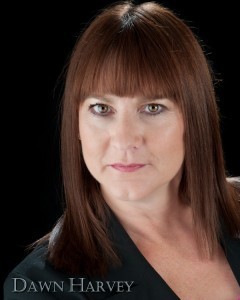 When Iambik picked up the contract to do an audiobook of OuterDiverse (Book 1 of The Splintered Universe Trilogy by Starfire), I was already
When Iambik picked up the contract to do an audiobook of OuterDiverse (Book 1 of The Splintered Universe Trilogy by Starfire), I was alreadyexcited. I had no idea how fun and fulfilling the experience was going to be.
Iambik provided me with a few voice artists, all who were great,
to narrate Outer Diverse. Something about Dawn’s voice—how she spoke as Rhea
Hawke—resonated with me. I was vindicated a thousand fold in selecting her to
be the “voice” for Outer Diverse. Working with Dawn was a pleasure. Dawn is a
dedicated professional; she created unique and consistent voices for the book’s
thirty-odd mostly alien characters. She ensured that each character had the
appropriate vernacular, tone, accent and cadence. Then she did proofs and
confirmed them with me. She also tackled the “alien” vocabulary; Rhea’s
universe is full of strange and foreign terms. Dawn sent me a list to make sure
she was pronouncing everything correctly—mostly made-up words. This lady is
dedicated to her craft and her art!
I recently invited her to my ship for a pockta nectar and a chat
about her world. Here’s a snippet of the interview (she’s also a lawyer so I
had to condense the 30-odd pages into these; I’m sure you appreciate that. For
a small fee I will send you a full version of the interview.)
SF Girl:
Dawn, you’re an actress and voice over
artist through your company Dawn of
Voice. Tell us a little bit about how you got there. Where did you
come from, what were your dreams and aspirations, and where are you going?
Dawn:
Oh my,
such a simple question but never a simple answer. First off, I'm over
50 and, as you know, the older you get, the longer the stories get.
I'll try to just include the highlights. I started singing
basically when I started talking and first was paid to sing when I was 10
years old. Then, in high school, I became a drama geek and finished
three years of high school drama in a year and a half. In grade 11, I
took a law course, which I really loved. So, I was torn between going
into acting or law. In the end, I decided law was too much school so I
became an actress. Little did I realize that I would still be
"going to school" 35 years later! I entered the University of
Calgary, studying fine arts. Subsequently, I got married and left
university. I then went into the oil industry, working in an area
dealing with contracts and leases so, very legal related. I obtained a
certificate in Land Management by taking night classes at what was then Mount
Royal College; it's now Mount Royal University. I started trying to
have babies and, after several failed attempts, began to reconcile myself to
the fact that I was not going to be a mother. That being the case, I
decided that I would become a lawyer so began doing the work to make that
happen. Two years of university was required at a minimum to be
accepted into law school although most people already have an undergraduate
degree when they start. So, I returned to night school, this time at
the University of Calgary, in pursuit of a degree in Psychology, my back up
plan to a law degree. When I had achieved the number of courses
required for the equivalent of 2 years of university (not that many given my
fine arts courses and my transfer courses from MRC), I began applying to law
schools. Always the overachiever, I applied to 10 schools and was
accepted into 7. I attended Dalhousie University in Halifax and
obtained my law degree in the spring of 1991 - after giving birth to my first
child (pregnancy number 6) in the fall of 1990. During all of this
time, I continued to act in community and semi-professional theatre
productions to quench my thirst for performing. (Told you this was a
long story!) On graduation, we moved to Vancouver where I began practicing
family and criminal law and had my second child (pregnancy number 7 - they
told me I wouldn't get pregnant again unless I used fertility drugs.
They were wrong. Don't believe anything they say when it comes to
having babies!) After a few years of that life, it became apparent to
me that to practice family law, I would have to become "emotionally
hard". You can't be reduced to tears sitting in family court
listening to all of the horror stories that go on there when you're the
lawyer! I'm the kind of person who cries at every episode of Little
House on the Prairie and I like it that way. So, I decided to leave
that kind of law and I returned to Calgary and the oil industry where my law
degree would also serve me well. A couple of years later, pregnancy
number 10 produced baby number 3. Another "oops" and a true
miracle that one. I continued to work part-time in community and
semi-professional stage work and obtained an agent so I could also do film
work. So, now I seemingly had it all - lawyer, actress, mother.
In the midst of this, I stumbled into a Masters Degree in law, thinking
I would teach. After the birth of my third child, I was stricken with
arthritis in both my knees at a very early age. I began to fear that I
would end up in a wheel chair way too young and was devastated thinking about
not being able to perform anymore should that happen. Although I only
did it part-time, if you are stricken with the performing bug, you simply
can't imagine how you could live if you didn't have that outlet. So, in
the early 2000's, I began my voice over training. In 2009, I decided
that I could not continue to work full-time in the oil industry and part-time
in the performing world. I had denied myself long enough - I began a
five year mission to leave the oil industry and go into acting and voicing
full-time. So now, I am 1/2 way through that plan and working 14 hour
days, basically 7 days a week, in order to keep all of the balls in the air.
I am on track though. My audiobook career is now taking off; I am
in the middle of narrating two more titles for Iambik, a psychology textbook
and a collection of short stories. In addition, I have a lead role in a
television series called Poker Girls. So, my long term plan is to continue to
build my VO career, focusing on audiobooks, narration and animation. My
current audiobook goal is to be the go-to female narrator for both John
Grisham (I AM a lawyer after all) and Stephen King (I AM his number one fan
after all!). So, if anyone out there can hook me up with either of
those guys, I'll gladly purchase a copy of Outer Diverse for each
of them so they can sample my work. And, I want to also continue to
build on my film and television acting career. And, I want to say bye
bye to oil and gas very soon!
SF Girl:
Sounds like that time is coming soon! Outer
Diverse is the first book in The Splintered Universe Trilogy. What was the
first thing you thought of when you read Outer Diverse? What do you think of
Rhea Hawke? She’s had quite a ride already in Book 1. Will she make it to
Book 3? (cheeky grin)
Dawn:
Outer
Diverse is the first full-length novel I have ever voiced. When
I auditioned for it, I had only a page or two of the book to review so
imagine my shock and surprise upon reading the book and realizing that I was
going to be voicing over 30 different characters from over 20 different
species! So, my first thought upon completing my first read was,
OMG—what have I gotten myself into!?!?!?! I love Rhea. She is so
strong yet also so fragile; like many of us. She is also headstrong,
determined and fearless. I guess I can relate to her as I am also all
of those things. People don't usually see the fragile in either of us
but it is certainly there. And yes, she will make it to Book 3.
At least she'd better!
SF Girl:
How do you prepare yourself for a reading?
Do you have a protocol that you follow?
Dawn:
I've
taken a lot of training so have lots of advice to draw on from some amazing
teachers. Most of my training has been with Pat Fraley and Vanessa Hart
but I have also trained with Scott Brick, Jeffrey Kafer, Kathy Garver and
many others. But, in the end, you have to come up with the process that
works best for you. I'm a real spreadsheet girl so make use of them to
help me keep everything organized. So, the first thing I do is read the
book, cover to cover, to get a feel for the characters and the story. I
then go through the book again and start making my spreadsheets which set out
information about the characters including any personal characteristics
described in the book by the narrator, the character himself and anyone else
in the book that interacts with or talks about the character. When I
have all of that information gathered, I then complete a matrix on each
character that addresses voice characteristics for each. From those
characteristics, I come up with each character's voice. Then, I'm ready
to begin actually recording
SF Girl:
How long can you read for any stretch? What
are the best things about readings? What are the worst things?
Dawn:
When I
was a kid, all of my report cards said "Dawn is a good student but she
talks too much" so I guess I've always been in training. So far, I
haven't hit the limit of how long I can read. I take my laptop down
into my booth and start working. I usually have an objective in mind
for how much I want to get done at a session and generally won't quit until I
reach that target. I always go with a fully charged laptop and will
often work until I run out of power and the thing shuts down! I could
plug it in but I figure that, 2-2.5 hours is probably as much as I should
ever do without taking a break and that's about how long my laptop will go
without needing a charge, so this ensures that I won't overstay my welcome in
the booth! I get totally lost in the reading. I've always loved
reading out loud. I have absolutely no idea why it took me so long to
figure out I could do this for a living as I've been listening to audiobooks
for years. They're great for long car trips with kids. The worst
thing would have to be pronouncing foreign words. I want to do them
justice so try really hard to get them right but am not always confident I
have done so. Later today I have to record a few phrases in Mandarin
for a book I'm currently working on. I got assistance from an Asian
friend of mine but I'm so not looking forward to trying to make those words
flow naturally out of my mouth!
SF Girl:
What equipment do you use for narration?
Dawn:
My
recording software is Twisted Wave and I record on an Apple lap top. My
audio interface is an Apogee One and my mic an MXL-990. Been thinking
about upgrading that lately. I read the text using my iPad. I
edit on a desktop Mac using Rokit 5 speakers. Yes, I have drunk all of
the Apple kool-aid. It is better than a PC for doing audio and video
work and so it has taken over my world.
SF Girl:
You did at least twenty distinctive voices
in Outer Diverse. Voices ranged from a New Jersey-like accent for a Xhix to a
multi-timbral resonance for a Venik trader. How did you decide on which one
to use and how do you keep it all consistent in your head?
Dawn:
I take
my character clues from the script. In the case of Outer Diverse, I
felt the need to run my final decision for the characters by the author.
As this is part of a three book series, and I didn't know what was
coming in books 2 and 3, I felt it was very important to do this. I'd
hate to get to book three and then find out that character XYZ was supposed
to have a lisp! In the case of this book, I grouped the characters by
species. I felt it was important to have a "sameness" to the
voices of the species and then could vary each character within the confines
of their particular species. The easiest way for me to keep consistency
for each character is to give each a "representational" character.
So, for example, the voice of Rhea's boss, is my version of Lou Grant
from the old Mary Tyler Moore series. He may not sound like Lou Grant
to anybody else, and it's probably better if he doesn't, but when I do MY
impersonation of Lou Grant, the voice comes out the same every time.
So, that really works for me. The hard part is coming up with the
representational character to go with the description I have of the
character. So, sometimes, I have to modify it somehow like maybe a
character would be Lou Grant if he talked out of the right side of his mouth or
in a higher pitch, for example. Every time you add a little twist like
that, you get a new character voice. I had a multi-tabbed spreadsheet
to help me as well. One tab listed all of the characters and the
chapters they were in with color-coding to remind me of what species they
were. Another tab had each character's voice description and
representational character. So, when I went into the studio with a plan
of which chapters I would be reading, I could quickly see which characters
were in those chapters and then familiarize myself with their voices before I
started. If one had spoken several chapters ago, I could also go back
to that earlier chapter and just refresh my memory of that voice. Don't
let anyone tell you this isn't a lot of work!
SF Girl:
What was the most challenging voice in Outer Diverse and why?
Dawn:
The most
challenging voice for me was Shlsh Shle She. He was described as having
a squealing, slobbery, mushy voice like he had a mouth full of wet food.
His speaking apparatus was made up of a number of wet folds resembling
female genitalia. It was a real challenge to honour his physical
characteristics while still being understood. Not much point in
speaking if the listener can't understand what I'm saying. I cringed
when I did my character analysis and realized how many lines he had!
Apparently it all worked out ok in the end but that was scary!
Sf Girl:
What is your favorite voice in Outer Diverse
and why?
Dawn:
My favorite
voice is Benny, Rhea's ship. He's my version of C3PO from Star Wars.
I just love his character and he has the same name as my youngest son
who, though named Benjamin, decided he was to be called Benny when he was 5
years old. At 15, he's still Benny! I just loved the coincidence.
SF Girl:
How did you end up with Iambik? How do you
like it there? How does Iambik compare with other audiobook companies, say
Audiobook?
Dawn:
I
submitted my audiobook demo to them in the fall of 2011 and was accepted onto
their roster. When the next set of auditions came up, Outer
Diverse was among them so I auditioned, and the rest is history.
Since this was my first book, I can't really compare to other
companies. However, I understand that the big publishers do the editing
for you so I'm looking forward to working with them. As much work as
the audiobook preparation is, the editing takes twice as long yet again.
I would be so much happier if my job ended at the mic!
SF Girl:
Tell us a little about the process with
Iambik from receiving the book in your hands to the final proofs and edits.
Dawn:
Iambik
sends me the book, we agree on a delivery deadline and sign a contract.
Iambik loads the book up into a shared Dropbox folder and I download it
and start my review. After I have recorded and edited a chapter, I
upload it to the same Dropbox folder. A proof listener reviews the file
and send me any corrections required. I do the corrections and upload
it again. They check it again. This continues until all is well
and is repeated for each chapter. We work from a shared spreadsheet
(see, spreadsheets are my life) so we can keep track of where we are with
each chapter. Once all of the chapters are complete, Iambik compiles
them into one document to be ready for download and releases then to the
public.
SF Girl:
Have you ever turned down a narration job
and why?
Dawn:
Yes, but
so far only because I didn't have time to fit it into my schedule.
SF Girl:
Tell us about Poker Girls…I know you want to
(big silly knowing grin). What other roles have you played as an actress that
you are particularly proud of?
Dawn:
Poker
Girls is a 1/2 hour crime drama whose central character is Summer, an
undercover cop, who uses the game of poker to catch unsuspecting criminals.
I play Theresa, an alcoholic judge who was just recently kicked off of
the bench by her boss, Sophia, played by Judy Norton (Mary Ellen from the
Waltons). Poker Girls began as a film making apprenticeship assignment
and morphed into a webseries and now a TV series. The creator, writer
and executive producer, Jewelle Colwell, who also plays the lead role of
Summer, has put her heart, soul and a lot of money into making this happen
for over a year now and, as always, persistence pays off. We have been
picked up by the Converge network who has a contract to provide roughly 240
hours of programming in China. Poker Girls will be on that line up.
Converge will also air in Florida and they continue to seek a wider,
international audience. We are committed to providing 10 episodes but
have only one "in the can" as they say in the biz. Just a few
weeks ago, the financing was secured to shoot the remaining nine episodes so
we expect to begin shooting next month. For anyone interested, we continue
to seek product placement opportunities. Give us a product and the next
thing you know, it'll be in an episode of Poker Girls, being viewed in China
with a potential audience of 2.5 billion! You can find us on Facebook
if you'd like to make contact with Jewelle (Poker Girls, TV Series).
SF Girl:
Dawn you are BOSS! Are there any awards or
accolades out there for voice artist? If so, can you name them so I can vote
you in. Also, how can we help promote Dawn Harvey? How can people show their
appreciation for your fantastic voice and dedicated artistry?
Dawn:
There
are awards. Those I know of are the Audies (the academy awards of
Audiobooks), the Audiophile Earphone awards and you can become a Golden
Voice. I think the latter requires a few more books in the "amazing"
category than I have so far - LOL. Someday. I looked in Wikipedia
and it lists five awards, the Audies, Galaxy National Book Awards, Odyssey
Award, Grammy Award for Best Spoken Word Album, and TDK Australian Audio Book
Awards. I don't know about all of the other awards but I do know that
for the Audies, the 2012 deadline for books released by the end of July is
Aug 31 but the submission has to be made by the publisher. That's about
all I know
As far
as helping me, the best you can do is download the book, listen to it, love
it, tell all of your friends about it. You can contribute reviews to
the Iambik site and, once it is available on Audio, you can contribute
reviews there as well. You could also put comments on my website,
DawnofVoice.com. Oh, and don't forget to help me get in touch with
Stephen and John - let's get that 6 degrees of separation thing working for
me, shall we?
SF Girl:
Thanks
so much for joining me here on my ship and answering all my annoying
questions.
Dawn:
Thanks
for giving me this opportunity to spew forth ad nauseum.
SF Girl:
No
problem. I’ve been having some issues with parking my ship lately—orbit taxes
and such—so, I might be coming to you for advice…
Dawn:
Sure.
I’d be happy to help.
You can hear a sample
of Dawn’s work on "Outer Diverse", the Prologue, on my Tumblr site, SF Girl:
To get your copy
of the audiobook go to the Iambik Audiobook site. Purchase your copy for $6.99 and enjoy some
pure entertainment. Thanks, Dawn!
Published on September 02, 2012 20:43
August 29, 2012
The Last Summoner by Nina Munteanu NOW OUT
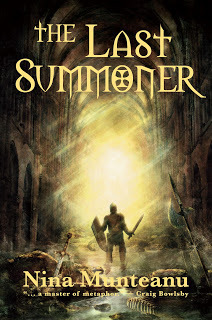
Nina Munteanu’s latest book The
Last Summoner is a Historical Time Travel Fantasy. Now available at
Amazon.com, Amazon.ca, The Book Depository (UK), Barnes & Noble and
Chapters and other quality bookstores near you.
Every Choice Has Its Price…
On June 14th, 1410 in Grunwald, Prussia,
one of medieval history’s most decisive battles is about to destroy the
powerful Teutonic Order, slaughtering virtually all its monk knights. How would
history have changed if this arrogant Nazi-like order had not underestimated
its enemy and had instead won to continue sweeping through north-east Europe,
unscathed, in its ambitious crusade for Christendom?
As a result of an impetuous choice, young
14-year old Vivianne Schoen, Baroness von Grunwald makes the startling
discovery that she can alter history—but not before she’s branded a witch and
must flee through a time-space tear into an alternate present-day France that she "authored" -- a France ruled
by fascists. There, she will learn that every choice has its price.
Enjoy this Canadian bestseller in print form or on your iPhone or similar device through Kindle.
Nina Munteanu is ”…A
master of metaphor.”— Craig Bowlsby
Published on August 29, 2012 22:13
August 23, 2012
Nina Munteanu's SF Thriller Now Audiobook
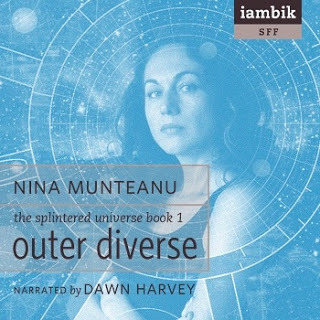
Nina Munteanu's space thriller Outer Diverse is now a scintillating audiobook by Iambik Audiobooks, narrated exquisitely by Dawn Harvey. Harvey breathes incredible life into this fast paced metaphysical thriller about a female detective who must solve the mystery of a spiritual sect massacre. Rhea comes alive alongside a gaggle of sordid and macabre characters in Harvey's rich narrative. A rollercoaster ride guaranteed to entertain.
Who needs coffee when you have Dawn Harvey!
Outer Diverse is the first book of the Splintered Universe Trilogy, set in and around the Milky Way Galaxy. The first book begins as Galactic Guardian Rhea Hawke investigates the massacre of an entire religious sect, catapulting her into a treacherous storm of politics, conspiracy and self-discovery. Her quest for justice leads her into the heart of a universal struggle and toward an unbearable truth she's hidden from herself since she murdered an innocent man.
What people are saying about Outer Diverse :
"A master of metaphor, Munteanu turns an adventure story into a wonderland of alien rabbit holes...a fascinating and enthralling read."--Craig Bowlsby, author of Commander's Log
"A rollicking science fiction plot with all the trappings...Hawke is a maverick in teh wild west tradition...a genetic mystery with lethal powers."--Lynda Williams, author of Okal Rel series
What people are saying about Dawn Harvey:
"I just finished and thoroughly enjoyed " Outer Diverse ". A metaphysical Sci Fi thriller with rich characters. Dawn Harvey told the story brilliantly and played the characters wonderfully. Definitely worth listening to."--Dan Wallace, narrator Lions Den Productions
"I am absolutely thrilled to recommend Nina Munteanu's audio book. Dawn has transported me into a new world of inspiration. Dawn is absolutely magic."--Vanessa Rottner
You can purchase this audiobook directly from Iambik for download to your Iphone or other device. It costs $6.99.
Go to my Tumbr site to hear a sample:
Published on August 23, 2012 19:23
August 20, 2012
Writer's Salon with Nina Munteanu
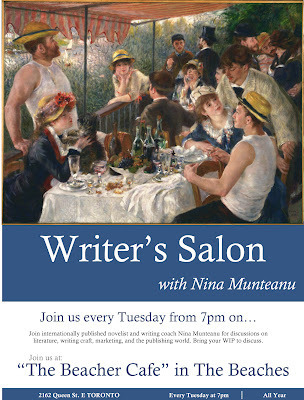
Join Nina and fellow writers every Tuesday at 7 pm at the Beacher Cafe in the Beaches of Toronto for lively discussions on all aspects of writing and publishing. Bring your WIP. Eat, drink, and discuss over a cappuccino and dessert or a delicious meal.
Next meeting is this Tuesday, August 21st. See you there!
Published on August 20, 2012 08:27
August 17, 2012
Costi Gurgu Aurora Prix Best Artist Finalist for Outer Diverse
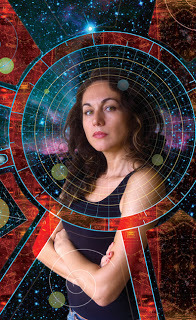
Congratulations to Costi Gurgu for being celebrated by the Aurora Prix Awards for his stunning cover art on the book cover of Outer Diverse (first book of The Splintered Universe Trilogy by Starfire World Syndicate).
Costi was recently honoured by the Auroras for his imaginative and elegant cover art that resonates impeccably with the story inside.
I recently interviewed Costi about his art and particularly what he created for Outer Diverse . Costi used a triptych approach for the three covers of the trilogy to reflect the evolution of the entire trilogy and the fractal relationship of the worlds represented.
Costi came up with the triptych approach to the three covers after a discussion about the story arc of the protagonist Rhea Hawke (a determined but troubled Galactic Guardian tasked with solving the mysterious massacre of an entire spiritual sect). Rhea Hawke is a complex character. Her journey of self-discovery and her three-stage evolution is reflected eloquently in Costi's cover art and design of the trilogy. What more could a writer ask for? I am honoured by his work.
Look for more of Costi's work in Books 2 and 3 of The Splintered Universe Trilogy . They are scheduled for release by Starfire in fall/winter of 2012 ( Inner Diverse ) and spring 2013 ( Metaverse ).
Published on August 17, 2012 09:16
August 6, 2012
Writing in Sync

“At
the heart of the universe is a steady, insistent beat: the sound of cycles in
sync,” says Steven Strogatz in the opening to his compelling book, Sync: the emerging science of spontaneous
order. He then describes how every night along the tidal
rivers of Malaysia, thousands of fireflies congregate in the mangroves and
flash in unison, without any leader or cue from the environment. “Even our
bodies are symphonies of rhythm, kept alive by the relentless, coordinated
firing of thousands of pacemaker cells in our hearts...almost as if nature has
an eerie yearning for order,” adds Strogatz. The tendency to synchronize
pervades the universe, from atoms to animals, and people to planets.
To be in sync is to intuitively connect (which is what
spontaneous order is) and “know”… Each of you has felt that “knowing”: that otherworldly,
euphoric wave of resonating with something that is more than the visible world:
when the hairs on the back of your neck tingle as you write that significant
scene or trembling with giddy energy as you create that perfect line on a
painting … or glowing with a deep abiding warmth when you defend a principle …
or the surging frisson you share with fellow musicians on that exquisite set
piece …
These are all what I call God moments. And they don’t happen
by chasing after them; they sneak up on us when we’re not looking. They come to
us when we focus outward and embrace our wonder for this world. When we quiet
our minds and nurture our souls with beauty. It is then that what we had been
seeking naturally comes to us. Like a gift.
It’s the blue pill to a new world of synchrony.
This teaches us above all else that we are all journeying
together and part of something greater.
I want to share with you my own experience of synchronicity
in art. When I’m working on a story, I find that events, opportunities, actions
and resources directly germane to my project present themselves: watching an
applicable movie that a friend chose for us to see; picking up a newspaper
(which I seldom do) and reading a relevant article; looking for something on
the internet and finding something totally different (ok; that happens to me
all the time); a friend out of the blue introduces a pertinent topic, or
someone you haven’t seen in a long time bumps into you with significant news.
As though the universe was providing me with what I needed. Well, maybe it was!
Of course, my mind was focused on anything to do with my current piece. It was
as though I had donned a concentrating filter, one that would amplify relevant
details. I’ll go further: I was unconsciously acting in a way that was bringing
me more information relevant to my project. Ask and you shall receive.
Jake Kotze says it this way: “Synchronicity happens when we
notice the bleed-through from one seemingly separate thing into another—or when
we for a brief moment move beyond the mind’s divisions of the world.” Swiss
psychologist Carl Jung introduced synchrony in the 1920s as “temporally
coincident occurrences of acausal events.” The idea of seemingly unrelated
events intersecting to produce meaningful patterns has spawned new notions of
thought from the scientific study of spontaneous order in the universe
(synchrony), to Synchromysticism — the discovery of convergent archetypal
symbols in pop culture (e.g., books, music and film). Author Sibyl Hunter tells
us that “Sync operates as an undercurrent of divine awareness personified
through the myriad processes and symbols that make up the building blocks of
our reality. Within that current, we spin our modern-day myths into books,
fairy tales and movies, subconsciously retelling ourselves the same story over
and over.”
As the myth builders of today, authors tap in to the
synchronicity of ancient story, of resonating archetypes and metaphor and the
“mythic journey”. To write in sync.
Joseph Campbell reminds us that, "Anyone writing a
creative work knows that you yield yourself, and the book talks to you and
builds itself ... you become the carrier of something that is given to you from
the Muses or God. What the shaman or seer [or artist] brings forth is something
that is waiting to be brought forth in everyone.” It’s sync in action.
Published on August 06, 2012 21:40
May 3, 2012
Moving From Prosaic to Spectacular
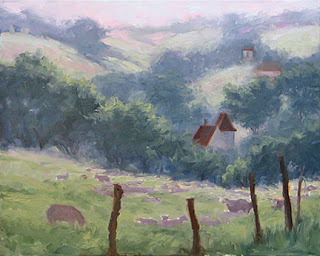
What makes some writing stunning and other writing lackluster? Mostly, it’s the language—the words—you use. And, it isn’t just what words you use; it’s how you use them. Here are a few things you need to consider when translating your work into something that “sings”.
Use Active Verbs and Reduce Modifiers
Many writers, not just beginners, slide into the pattern of using passive and weak verbs (e.g., were, was, being, etc.). Then they add a modifier to strengthen it. It doesn’t. Actively look for strong, vivid verbs. This is the key to good writing. Active and powerful verbs move a story forward. For instance, which version is more compelling?
Jill was walking quickly into the room.
or…
Jill stormed into the room.
The second example not only more quickly and efficiently demonstrates how Jill entered the room, but demonstrates with what attitude. There is no substitute for the use of powerful, appropriate verbs in sentences.
Avoid Excessive & Meaningless Prose
Novice writers often use too many words to describe an event, action or scene. An overabundance of words slows down the story and obscures plot and action. Excessive prose includes:
Repetition: many beginning writers will often first tell then show in a scene. You don’t need to do both; trust the reader to get the “show”.
Extraneous words: e.g. “he started to think” instead of “he thought”; use of the obvious such as “she saw the big man lying on the bed” instead of “a big man lay on the bed” (“she saw” is implied through her POV). This second example also demonstrates how you can shift the readers’ attention from “her seeing” (in the first phrase) to “the man lying” on the bed (in the revised phrase). This simple change can create a much more powerful sentence through the seamless shift in reader attention.
Dull description not related to plot: I recently edited a writer’s over 400-page urban fantasy that contained far too much ordinary detail. Detail that, in small doses, may have enlightened the reader on the qualities of the protagonist; but in larger doses ground the narrative to a boring halt.
When you look for a more efficient and purposeful way to say something, you cut out unnecessary detail. Remember that virtually all description should be related to the plot and theme of the story.
Alliteration, Metaphor, Simile, Personification
These devices bring lyricism and cadence and powerful imagery to your prose. However, as with anything powerful, you need to use these judiciously. Use them where you wish to convey a strong image and to punctuate your prose.
Be Mindful of Word Accuracy
More often than you might think, a writer inadvertently misuses a word to convey an idea or emotion. For instance, let’s consider the following sentence, which describes a character’s reaction to a dog being cruelly mishandled:
“What are they doing?” Jack said crossly.
The modifier crossly suggests that Reginald lacks compassion; it infers petulant annoyance.
“What are they doing?” Jack scowled.
Scowled still suggests the same icy disdain, though it may have been delivered with false bravado or through genuine discomfort from a hidden compassion. If the writer wished to convey shock, disgust or compassion, the following would better represent that sentiment:
“What are they doing?” Jack said, eyes wide.
or:..
“What are they doing?” Jack stammered.
Avoid Using Words like “Felt” or “Seem”
These “telly” words prevent the reader from directly experiencing the story by imposing a level of interpretation. For example, “he felt himself falling” can be improved to “he fell”. If you want to spice up the phrase, use another verb: “he toppled” “he stumbled” or “he crashed”.
Read your Writing Aloud & Punctuate Your Pauses
It isn’t just a clever metaphor when they say your writing style is called your “voice”; because your readers “listen” to what you write. Reading out loud helps define cadence, tone and pace of your prose and streamlines your writing. When you read aloud, pay attention to where you naturally pause. You may wish to put in a comma, semi-colon or period there.
Size and Vary Your Paragraphs
Paragraphs are visual elements that help people read; they break up text on a page in logical places to provide white space for reader ease. I’ve heard people quote the “two-inch” rule for maximum paragraph length and I concur. This is one of the reasons some passages are harder to read than others; long paragraphs are more tiring to the eye. Find those logical breaks and put them in. Varying paragraph length creates a more interesting story “landscape” for the reader. Don’t be afraid to go to some extremes like using the one sentence – or even one word – paragraph.
Size and Vary Your Sentences
As with paragraphs, overly long sentences can try a reader’s patience and you may lose them entirely. Too many short choppy sentences can also reduce your prose to a mundane level. Varying your sentence length in a paragraph creates the lyricism and cadence that makes prose enjoyable to read.
Published on May 03, 2012 00:01



